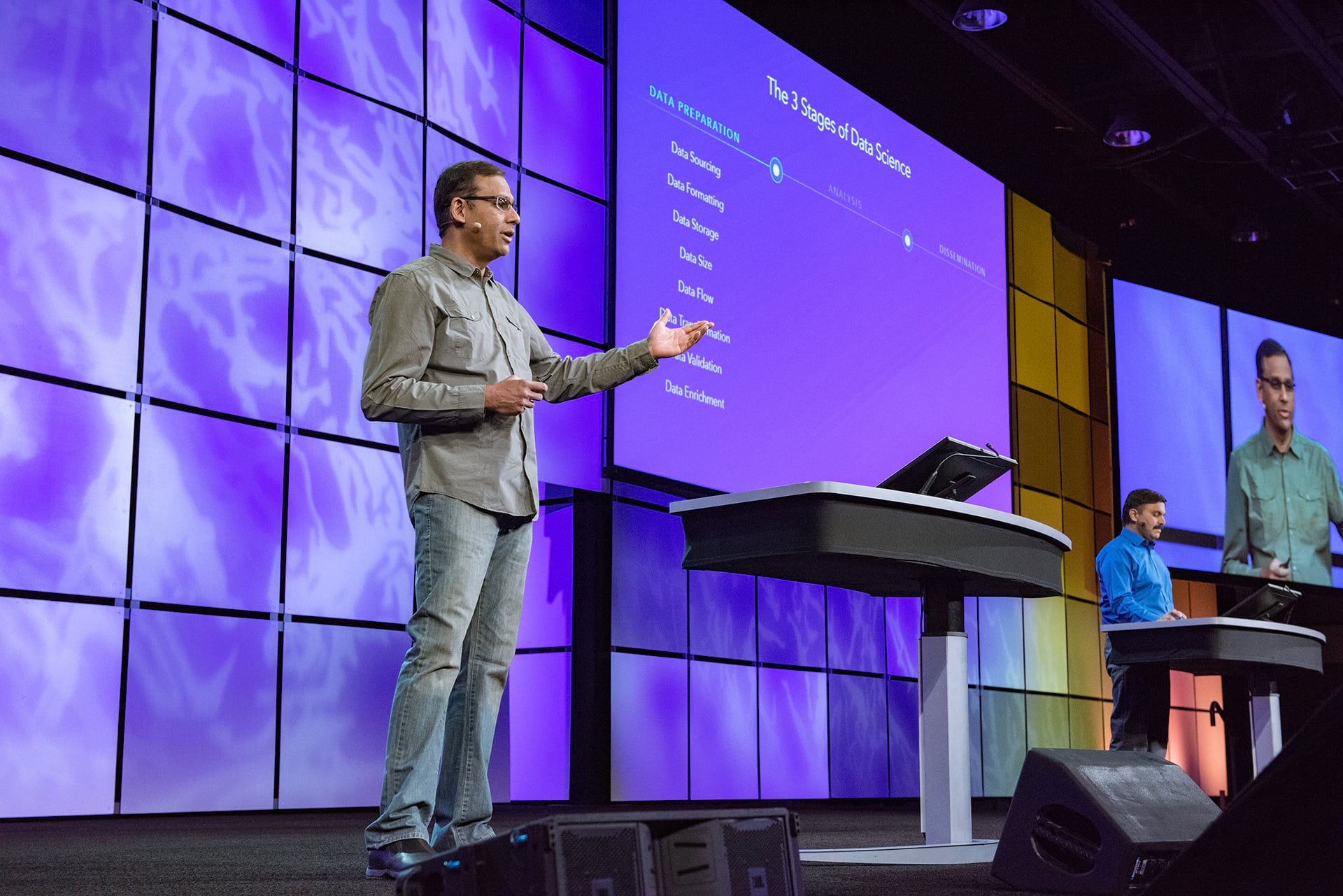The month of March brought three great conferences – the Esri Partner Conference and Developer Summit in Palm Springs, and the Esri Federal GIS Conference in Washington, D.C. While the difference in weather between the two locations was quite a shock, we on the ArcGIS Enterprise product team roundly enjoyed the chance to meet our users, answer questions, and show off the latest and greatest stuff we’ve been working on. Thanks to everyone who joined us – whether you soaked up the Coachella Valley sun or braved the East Coast snowstorm, you’re the reason we’re here.
Now that these spring conferences have been wrapped up, I’d like to cover some of the most common questions we heard from users last month. The four questions here range across the software components of our platform, as well as the ever-pertinent install and upgrade tools we offer. Let’s get started!
Couldn't make it to #DevSummit? Don't worry! You can watch all of the exciting moments of the Plenary Session here: https://t.co/KSEb8pItIj #ArcGIS #Tech pic.twitter.com/MCFJRcHP02
— Esri (@Esri) March 11, 2018
I have been using ArcGIS Server for years, but want to know what value a portal would bring to my implementation. Why should I adopt a full-stack ArcGIS Enterprise deployment?
Web GIS is a foundational pattern available both in ArcGIS Enterprise and ArcGIS Online. It includes a portal (the ArcGIS Enterprise portal or ArcGIS Online organization) to centralize and organize your GIS assets and data. The portal enables members in your organization to share and consume services and layers in the form of web maps and apps. Because web maps are the foundation to the suite of ArcGIS apps, including ArcGIS Pro, you can extend these shared items into the apps with no coding required.
For many customers who have a standalone ArcGIS Server, their workflows may not seem to require the full Web GIS pattern provided by ArcGIS Enterprise. They are publishing services from ArcMap to their servers, performing in-depth analysis, and publishing maps to inform decision-making. Because many are developers, they are serving out their service endpoints in custom JavaScript web applications. It’s a self-contained system that is familiar and works for them.
What might be considered if your case is like theirs, though, is what new capabilities and practices you can bring to your organization with a modern Web GIS platform, and what new audiences – inside and outside of your organization – can share in the transformative functions and products of GIS. Since ArcGIS Server was first introduced in 2004, an incredible range of new products have been integrated into the ArcGIS platform. ArcGIS delivers a suite of apps (from apps for the field and office, to the powerful desktop software ArcGIS Pro) that are built to extend the capabilities of your Web GIS.
Some of the things you can do when you have an ArcGIS Enterprise portal:
- Share your maps quickly and easily with the rest of your organization, without the need to build a custom app.
- Plug your data into Insights for ArcGIS for powerful analytics.
- Build an intuitive lightweight app from your map using Web AppBuilder, or a completely customized one using AppStudio.
- Set up a distributed collaboration between multiple portals (whether Enterprise or Online) to organize, edit, and share geospatial content in a secured, trusted arrangement.
- Integrate your data collection and management workflows into your GIS with Collector for ArcGIS, Workforce, Operations Dashboard, and Survey123 apps.
Now, security concerns may be prominent in customers’ minds. The primary security change that takes place when you adopt the full ArcGIS Enterprise stack is that authentication is bumped up from server-tier to web-tier. Once your server is federated in the portal, the authentication now takes place in the portal. Secured services become items in the portal and they can be shared to individuals in groups or throughout the organization. The portal can be configured to allow single-sign on for the organization (e.g. with Integrated Windows Authentication or SAML-compliant identity providers) in the same way that Server can.
ArcGIS Enterprise is still completely managed within infrastructure that you control. This infrastructure can be bare-metal machines on-premises, virtualized machines, or cloud infrastructure. Many ArcGIS Enterprise customers even deploy their system in a completely disconnected environment – zero open internet. When you install or upgrade to ArcGIS Enterprise 10.6, you are receiving the most up-to-date security measures, designed to mitigate modern threats and work seamlessly with your external identity provider.
You can get by just fine cooking with only a gas burner, but if you have a full kitchen, the range of possibilities and the quality of your output increases immensely – and the same is true with ArcGIS Enterprise. You can get by just fine with a standalone ArcGIS Server, but consider the things your organization could do if you had a full-stack Web GIS platform with ArcGIS Enterprise. (I should really stop writing blogs before lunch.)
Before migrating your standalone ArcGIS Server to ArcGIS Enterprise, take a look at our new white paper, conveniently titled “Migrating standalone ArcGIS Server to ArcGIS Enterprise.” You’ll find more details and a full-length introduction to the Web GIS model, along with diagrams of the different methods you can take to migrate your system.

What tools does Esri have to automate my ArcGIS Enterprise installations or upgrades?
We’re determined to make ArcGIS Enterprise as easy as possible to deploy. That’s why Esri has developed a range of automation tools for the installation and upgrade stages of your deployment, and are working hard to expand them. In brief:
Single-machine deployments:
- The ArcGIS Enterprise Builder is an easy installation and configuration wizard that will set up a base Enterprise deployment on one machine in about an hour. At 10.6, it’s capable of upgrading a 10.5.1 deployment originally set up by the builder, and now has a command line utility, if that’s more your speed. For single-machine base deployments that are ready out-of-the-box, look to the Enterprise Builder.
Cloud deployments:
- An alternative to hosting your deployment on-premises is to use the cloud. When you’re installing and upgrading in the cloud, we can help you automate that, too. Esri provides Amazon Web Services CloudFormation templates and Cloud Builder command line interface, Amazon Machine Images (AMIs) and a Cloud Builder for Microsoft Azure. With these tools, you can stand up your deployment in the cloud even if you’re not a “cloud native” (which is what I hear we’re calling the new generation of kids).
Multi-machine deployments:
- For multi-machine deployments, we have resources for the Chef IT automation toolbox. Chef uses a server-client model to automate installation and configuration tasks, and our team publishes “cookbooks” and guides that give you all you need to deploy ArcGIS Enterprise across multiple machines, in high-availability configurations, and/or for repeatable deployments. We’ve got a brand new site to help you get started with Chef, and video guides on the way!
- When you want or need to upgrade Enterprise components one by one, we’ve introduced command line utilities in 10.6. Using the upgradeserver and upgradeportal tools make it easy to perform component upgrades from your console.
Learn more about automation in ArcGIS Enterprise

Does ArcGIS Data Store replace or supersede my enterprise geodatabases?
No, it is not intended to do so. Your enterprise geodatabases remain an essential component of your GIS regardless of whether they’re based on Oracle, SQL Server, or any of the many other databases that ArcGIS supports.
ArcGIS Data Store, which is included with ArcGIS Enterprise, is a simple-to-manage database that hosts data copied to the system and data that is generated by system as part of several types of analysis workflows. It doesn’t require a lot of the back-end administration otherwise associated with general purposes databases. As part of the ArcGIS Enterprise base deployment, the ArcGIS Data Store is configured as two types: relational (for hosted feature layers), tile cache (for hosted scene layers). Then, it can be optionally configured as a spatiotemporal big data store (for real-time and/or large-volume data, as with GeoEvent Server and GeoAnalytics Server). In other words, it’s great! But it’s not designed to replace what your enterprise geodatabase has been doing.
Learn more about ArcGIS Data Store

How can I get started using distributed collaboration to share and edit content across Enterprise deployments and with ArcGIS Online?
Easily! We would first recommend sketching out your intended workflow. What types of data are you looking to share? How often will you be updating shared data? Who would you like to collaborate with? These are all considerations to keep in mind — but look out for a series of blogs to come on best practices for distributed collaboration.
When you’re ready to set up the collaboration, head over to the collaboration tab in Organization > Edit Settings in your Enterprise portal (or ArcGIS Online). From there, an administrator can configure and invite guests to the collaboration. Then, members of your portal are free to share content to the groups that are part of the collaboration. You can share feature layers, map services, static files and more. Items you share to your own group will be discoverable for other participants within their group, extending your GIS above and beyond.
Learn more about distributed collaboration
We look forward to seeing you (and answering more of your questions) at the 2018 Esri User Conference in San Diego this July! Don’t forget to register if you haven’t already.
And continue to follow our ArcGIS Enterprise blog here — we always have more introductions, explainers, and FAQs on the way — as well as our Twitter, @ArcGISXprise.
Article Discussion: